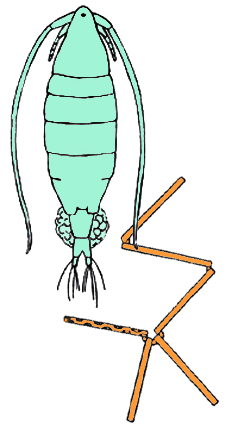June 23rd, 2013 § § permalink
Last week I took a field trip to the Dutch Kills tributary of Newtown Creek with Drs. Michael Levandowsky and Sarah Durand to sample plankton. Sarah is a fixture on Dutch Kills, and is currently enjoying her sabbatical from LaGuardia Community College (although sabbaticals do tend to become as full of responsibility as ever, I am learning), located steps from the infamous Superfund site. She and her colleague Dr. Holly Porter-Morgan, the director of the environmental science program at LaGuardia, have regularly brought their classes out to sample water and benthos on the creek, and are the resident scientists of Newtown Creek. Michael I have introduced already.
Finding a time for all three of us to get together on my favorite underdog waterbody was something I had been looking forward to for awhile.

Michael on plankton and Sarah on dissolved oxygen.
Despite popular opinion, Newtown Creek is alive. I would never use adjectives such as “clean”, “pathogen-free” or “high-functioning”, but I can state with some authority that Newtown Creek is surprizingly alive. The ecosystem that exists today in the backyard of the Industrial Revolution is what one might call “impaired”, hamstrung by historic contamination and persistent sewer overflows, but it limps along (and occasionally leaps!) nonetheless.
Dutch Kills has always been fascinating to me, as it lies on a transitional borderline between the relatively good water quality at the mouth of Newtown Creek, and the “heart of darkness” further up. There is a large CSO that functions as the headwaters, and the entire tributary might suddenly turn a milky mint green, precipitate gloopy green algae blobs, and then turn a tea-like red the next day. She moves in mysterious ways.
Sarah hosted our dip, and allowed us to take a preliminary look at our findings back at the lab. We used two different tows, one of coarser and one of finer mesh. This is what we saw in the coarser mesh:

Clockwise from top left: Possibly a freshwater alga, a barnacle larva, something of botanical origin that stumped us, and a skeletonema.
Michael made off with an aliquot of the fine mesh sample and reported… “I looked at the sample from the 10 um tow and it’s rich in phytoplankton. Skeletonema dominates, but there are also dinoflagellates, and much else.”
More will be revealed!
June 2nd, 2013 § § permalink
In the early aughts I had a job running education programs at the Lower East Side Ecology Center. I was tasked with interpreting the East River ecosystem, a tidal strait within the NY/NJ Harbor Estuary, for city kids and passersby on the East River Park Esplanade.

Me and the Berthos girls fishing on the East River, circa 2004.
It was a great job. GREAT. And I wanted to keep it. So I went diligently searching for any foundational literature, research historic or ongoing, existing curricula, anything about the East River that I could base my programs on. I was petrified when I found…nothing. For the East River, the only flora and fauna that people seemed to write about were of the forensic variety. Only its sullied reputation preceded it.
I heard about one guy down at Pace University, who had been doing water and plankton sampling on a weekly basis “since 1989 or so” from the South Street Seaport. It was technically the Upper Harbor, but it would have to do.
So I cold called Dr. Michael Levandowsky, and he was kind enough to take me along. He introduced me to the supreme scientific instrument, the Bucket on a Rope. (I went on to require all my classes to repeat after me in unison, “YOU DON’T. LET GO. OF THE ROPE!”) He also showed me the Winkler titration method for measuring Dissolved Oxygen, how to assess salinity with a refractometer, and how to run a plankton tow.

Michael Levandowsky wielding a Bucket on a Rope in The Water Underground video, from Center for Urban Pedagogy.
So when I returned to thinking and writing about plankton a decade later, I thought I would check in with Dr. Levandowsky. Again he was kind enough to take me along.

Michael Levandowsky at the Sackler Institute of Comparative Genomics.
Today he is working, among other places, uptown at the American Museum of Natural History, in the Sackler Institute of Comparative Genomics, where he smashes his poor plankton samples into a slurry of genetic information and runs them into gels that he can read with greater accuracy than the method he’s used for most of his career (morphological identification through a microscope).
On his bench were samples from all over the world, and in the lab were an international crew of colleagues studying various aspects of planktonic – and other – life.
Despite the uptown digs and new fangled genetic analysis, I suspect that the Bucket on a Rope is still integral to the work…
June 2nd, 2013 § § permalink
Fung Lim at North Brooklyn Boat Club reported to me at my post at Newtown Creek Alliance that the ever-troubled creek had turned a dramatic shade of dark red. We went looking for answers:

Photo by Fung Lim
Randall Austin from NYSDEC – “Conditions would be right for an algal bloom: rainfall (runoff) followed by a “heat wave” – would kick up the algae count…these normally occur at the end of the Summer when the ambient water temp has risen gradually. It can happen under the recent weather circumstances, though.”
John Lipscomb from Riverkeeper – “Yes we see it often in summer during sunny dry spells. I was on Newtown Creek last Friday and we saw it then.”
In conclusion, phytoplankton eat sewage and love sunshine.






